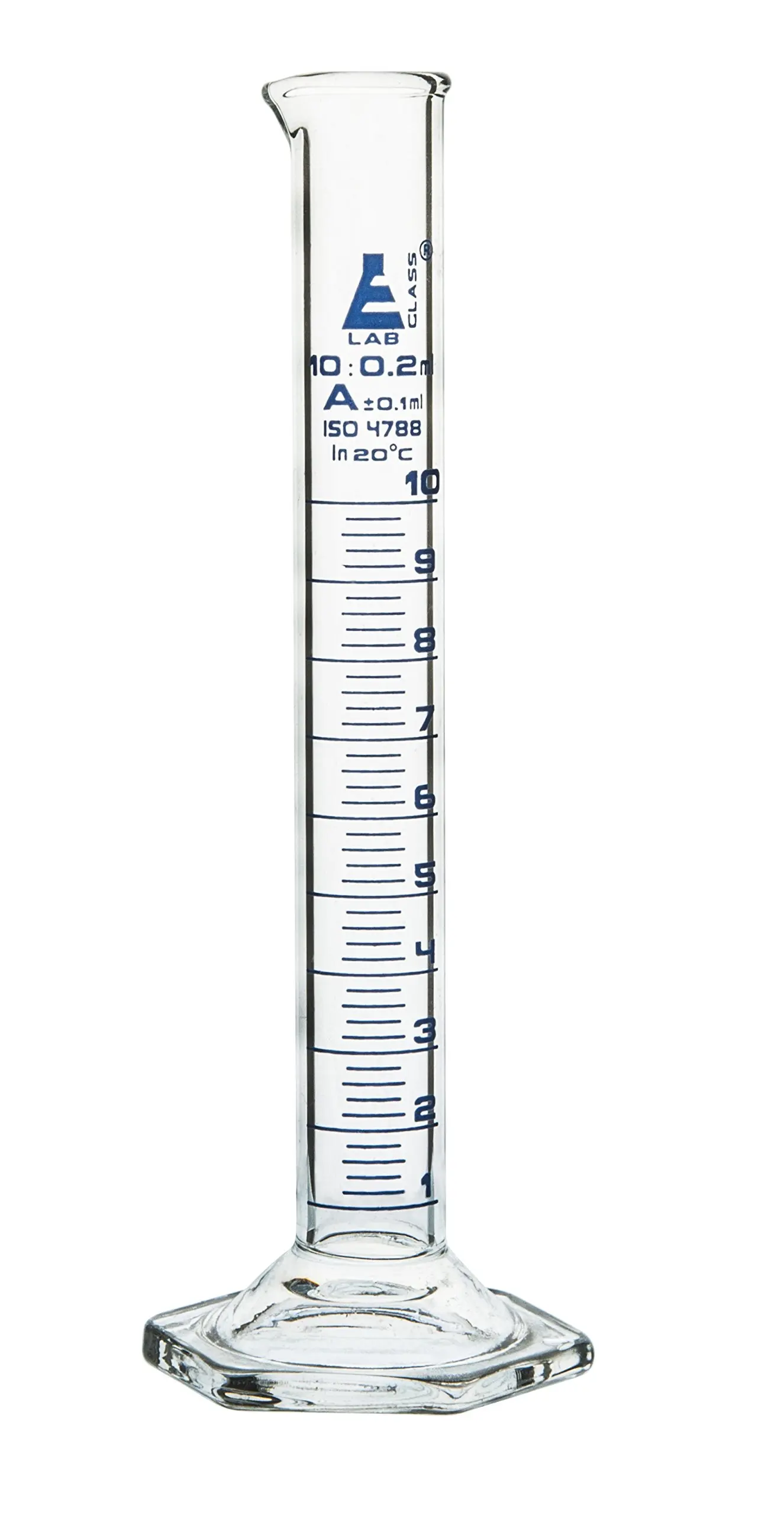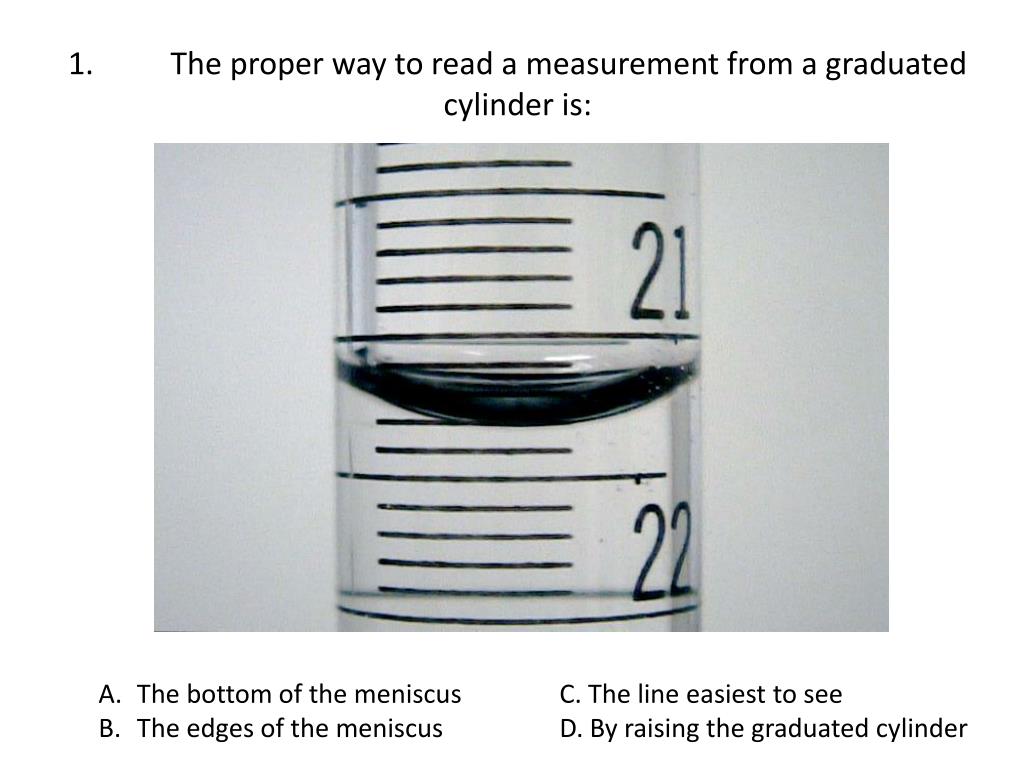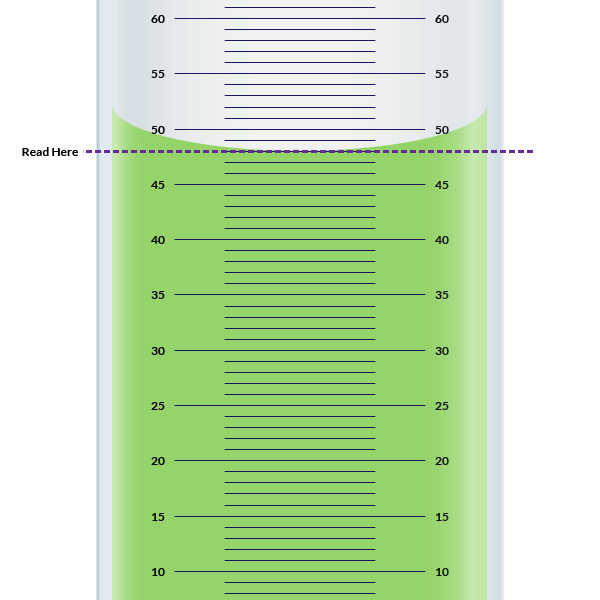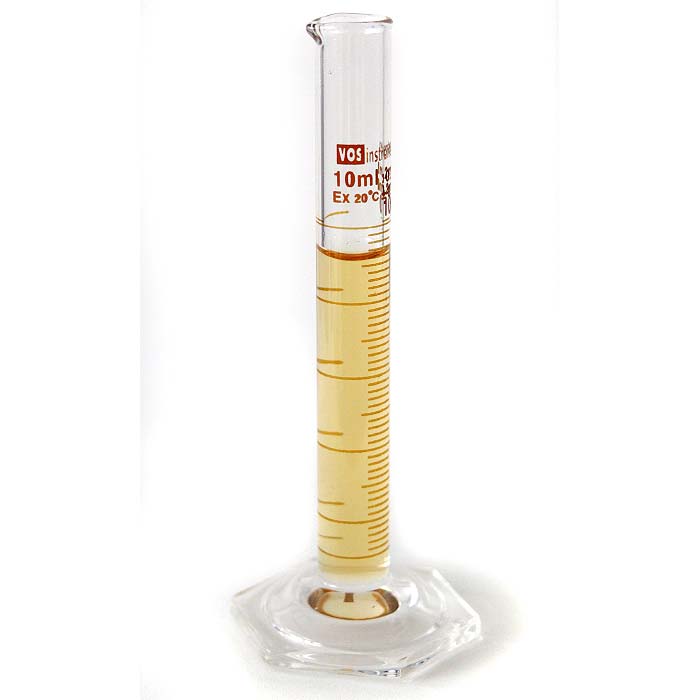How To Read A 10 Ml Graduated Cylinder
How To Read A 10 Ml Graduated Cylinder - Depending on the size of the graduated cylinder and the graduations, the uncertain digit may be to the milliliter ( 1x ), the tenth of a milliliter ( 1.x. Pour distilled water into the cylinder, up to 25% of its total capacity (be careful to measure the exact volume). Remember that space equals volume. If the cylinder is too large to fit in your hand, it may be a good idea to buy a smaller one. Web reading a graduated cylinder starts with dividing the difference between adjacent numbered lines by the number of unmarked lines counted from one numbered line to the next. What are the lines on a graduated cylinder? Accepts a small range of estimates for the final digit in the reading. Web the uncertain digit (the last digit of the reading) is estimated. If you are unsure of the size of your cylinder, you can measure it with a caliper. You can also use a ruler to measure the diameter of a cylinder.
Web measure so that the line you are reading is even with the center of the meniscus. There are two types of data. What's the meaning of dwag? Is a 10 ml or 50 ml graduated cylinder. You can also use a ruler to measure the diameter of a cylinder. Find the center of the meniscus. Checks accuracy of measurement and provides feedback. 5 ml/10 spaces = 0.5 ml per space the answer tells you the value between each marked graduation on the cylinder. Pour distilled water into the cylinder, up to 25% of its total capacity (be careful to measure the exact volume). Depending on the size of the graduated cylinder and the graduations, the uncertain digit may be to the milliliter ( 1x ), the tenth of a milliliter ( 1.x.
Depending on the size of the graduated cylinder and the graduations, the uncertain digit may be to the milliliter ( 1x ), the tenth of a milliliter ( 1.x. There are two types of data. Web the uncertain digit (the last digit of the reading) is estimated. Remember that space equals volume. The correct reading is 30.0 ml… Web reading a graduated cylinder starts with dividing the difference between adjacent numbered lines by the number of unmarked lines counted from one numbered line to the next. Next, count that there are ten intervals between the labeled graduations. Web how to use a graduated cylinder. You can also use a ruler to measure the diameter of a cylinder. If you are unsure of the size of your cylinder, you can measure it with a caliper.
Cheap Graduated Cylinder 10ml, find Graduated Cylinder 10ml deals on
Place the cylinder on the weighing balance. What are the lines on a graduated cylinder? A graduation is 0.5 ml. If you are unsure of the size of your cylinder, you can measure it with a caliper. Pour distilled water into the cylinder, up to 25% of its total capacity (be careful to measure the exact volume).
Reading A Graduated Cylinder slidesharedocs
Tare the balance to make the reading zero. Depending on the size of the graduated cylinder and the graduations, the uncertain digit may be to the milliliter ( 1x ), the tenth of a milliliter ( 1.x. Find the center of the meniscus. Checks accuracy of measurement and provides feedback. Web how to use a graduated cylinder.
Best 10 Ml Graduated Cylinder out of top 19 in 2020
Then pour the sand in. What's the meaning of dwag? If there were no air, it would fill the graduated cylinder to the 100ml line. Empty the water into a clean beaker. Quantitative data involves numbers, such as the.
Measurement Uncertainty, Accuracy, and Precision Chemistry I
Pour distilled water into the cylinder, up to 25% of its total capacity (be careful to measure the exact volume). For mercury, take the measurement from the top of the. Web one graduation therefore = 1/10 ml, or here subtract 6 from 7 (answer = 1) and count that there 10 graduations between the 6 and 7 labelled graduations. Remember.
PLASTIC GRADUATED MEASURING CYLINDER 10 ML Science2Life
Therefore, the scale increment is 2 ml/10 graduations = 0.2 ml/graduation. Web an easy way to find out is to fill the 100ml graduated cylinder exactly halfway, i.e. To measure the volume of liquid in this graduated cylinder, you must mentally subdivide the distance between the 21 and 22 ml marks into tenths of a milliliter, and then make a.
50 mL Graduated Cylinder for Measuring Home Science Tools
10 spaces divide the value between the graduations by the number of spaces. The correct reading is 30.0 ml… Depending on the size of the graduated cylinder and the graduations, the uncertain digit may be to the milliliter ( 1x ), the tenth of a milliliter ( 1.x. Pour distilled water into the cylinder, up to 25% of its total.
VOS 10ml Graduated Measuring Cylinder Borosilicate Glass BCG Film
You can also use a ruler to measure the diameter of a cylinder. Accepts a small range of estimates for the final digit in the reading. If there were no air, it would fill the graduated cylinder to the 100ml line. Find the center of the meniscus. Therefore, the scale increment is 2 ml/10 graduations = 0.2 ml/graduation.
10 mL Graduated Cylinder for Measuring Home Science Tools
If there were no air, it would fill the graduated cylinder to the 100ml line. A graduation is 0.5 ml. For mercury, take the measurement from the top of the. 10 spaces divide the value between the graduations by the number of spaces. Web the uncertain digit (the last digit of the reading) is estimated.
1000 ml Graduated Cylinder polypropylene
Web 15 ml — 10 ml = 5 ml count the number of spaces between the 2 graduations. Place the cylinder on the weighing balance. Pour distilled water into the cylinder, up to 25% of its total capacity (be careful to measure the exact volume). Web the uncertain digit (the last digit of the reading) is estimated. Quantitative data involves.
25 ml glass graduated cylinder, glass
Empty the water into a clean beaker. Web the uncertain digit (the last digit of the reading) is estimated. 10 spaces divide the value between the graduations by the number of spaces. There are two types of data. If there were no air, it would fill the graduated cylinder to the 100ml line.
Quantitative Data Involves Numbers, Such As The.
Web 15 ml — 10 ml = 5 ml count the number of spaces between the 2 graduations. Accepts a small range of estimates for the final digit in the reading. Find the center of the meniscus. If the cylinder is too large to fit in your hand, it may be a good idea to buy a smaller one.
You Can Also Use A Ruler To Measure The Diameter Of A Cylinder.
Pour distilled water into the cylinder, up to 25% of its total capacity (be careful to measure the exact volume). Tare the balance to make the reading zero. What are the lines on a graduated cylinder? Remember that space equals volume.
The Correct Reading Is 30.0 Ml…
Web the graduated cylinders are always read to 2 decimal places. To measure the volume of liquid in this graduated cylinder, you must mentally subdivide the distance between the 21 and 22 ml marks into tenths of a milliliter, and then make a reading (estimate) at the. If there were no air, it would fill the graduated cylinder to the 100ml line. 5 ml/10 spaces = 0.5 ml per space the answer tells you the value between each marked graduation on the cylinder.
Therefore, The Scale Increment Is 2 Ml/10 Graduations = 0.2 Ml/Graduation.
A graduation is 0.5 ml. Then pour the sand in. Qualitative data collecting data is an important part of any scientific investigation. For water and most liquids, this is the bottom of the meniscus.









